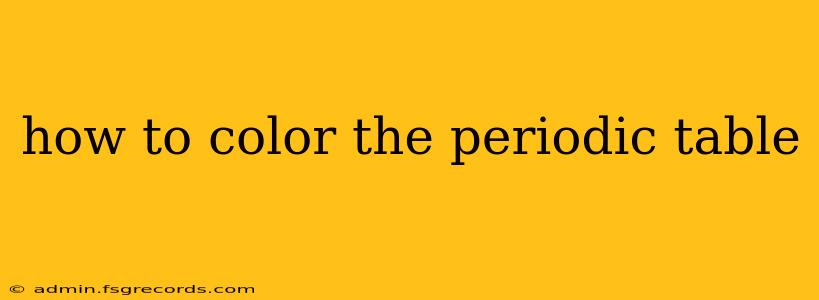The periodic table, a cornerstone of chemistry, can be a visually engaging tool when color-coded effectively. Coloring the periodic table isn't just about aesthetics; it's a powerful way to highlight trends, categorize elements, and deepen understanding of chemical properties. This guide will explore various methods for coloring the periodic table, catering to different needs and learning styles.
Why Color-Code the Periodic Table?
Before diving into the how, let's understand the why. Color-coding the periodic table helps:
- Visualize Trends: Grouping elements by color based on their properties (like electronegativity, reactivity, or atomic radius) immediately reveals patterns and trends across periods and groups.
- Improved Learning and Retention: Visual learners benefit immensely from color-coded representations, improving memory and comprehension.
- Simplified Categorization: Quickly identify elements belonging to specific groups (alkali metals, halogens, etc.) based on their assigned color.
- Enhanced Problem-Solving: Color-coding can simplify complex chemical problems by visually representing element properties.
Methods for Coloring the Periodic Table
Several effective strategies exist for color-coding the periodic table, each with its own advantages:
1. By Group/Family:
This is perhaps the most common method. Each group of elements (alkali metals, alkaline earth metals, halogens, noble gases, etc.) receives a distinct color. This clearly distinguishes families and their shared characteristics.
- Example: Alkali metals (Group 1) could be light blue, alkaline earth metals (Group 2) light green, and so on. This method emphasizes the vertical relationships within the table.
2. By Block:
Elements are categorized based on the electron subshell being filled (s-block, p-block, d-block, f-block).
- Example: s-block elements might be yellow, p-block elements orange, d-block elements purple, and f-block elements a shade of pink. This highlights the electronic configuration and orbital filling patterns.
3. By Metal, Nonmetal, and Metalloid:
This simple approach uses three distinct colors to differentiate between the three major element categories.
- Example: Metals could be various shades of blue or grey, nonmetals could be red or yellow, and metalloids a green or a teal color. This method is ideal for introductory chemistry levels.
4. By Electronegativity:
Coloring based on electronegativity (an element's ability to attract electrons) creates a gradient. Elements with high electronegativity receive darker shades, while elements with lower electronegativity are lighter.
- Example: A spectrum from light blue (low electronegativity) to dark red (high electronegativity) effectively illustrates this trend across the table.
5. By Atomic Radius:
Similar to electronegativity, a color gradient can represent atomic radius, with larger atoms receiving darker shades and smaller atoms lighter shades.
6. By Other Properties:
Other properties like ionization energy, reactivity, melting point, or boiling point can also be effectively visualized using color gradients or distinct colors.
Tools and Resources
Many online tools and printable periodic tables facilitate color-coding. You can find interactive versions online where you can customize the colors and properties displayed. Several educational websites provide printable periodic tables already color-coded by various properties. You can also create your own using spreadsheet software like Microsoft Excel or Google Sheets.
Tips for Effective Color-Coding
- Choose a clear and consistent color scheme: Avoid using too many colors or colors that are too similar.
- Use a legend: Always include a key explaining the color-coding system.
- Consider the audience: The complexity of the color-coding should be appropriate for the target audience (e.g., elementary school vs. university students).
- Experiment: Try different color schemes and methods to find what works best for your learning style or teaching goals.
By understanding the various methods and employing effective visualization techniques, you can transform the periodic table from a static chart into a dynamic and engaging learning tool. Remember, the best way to color your periodic table is the way that makes the most sense to you and helps you understand the fascinating world of chemistry.

